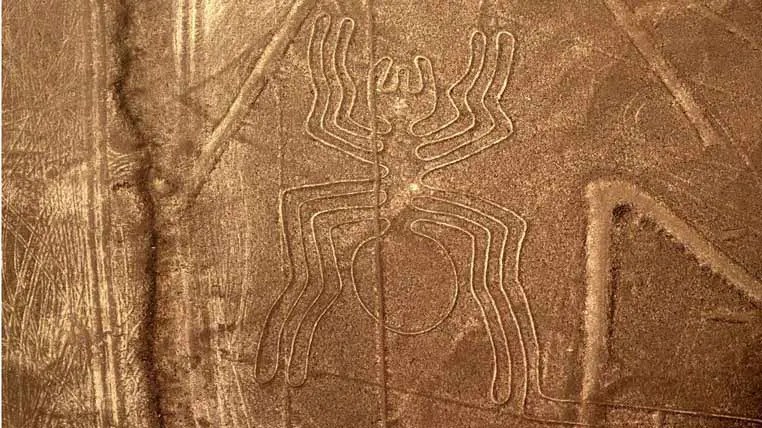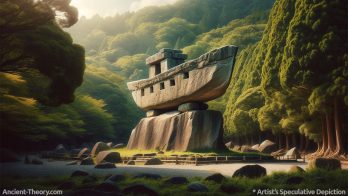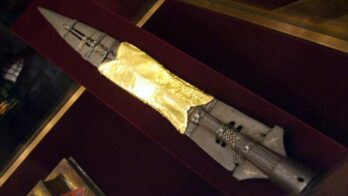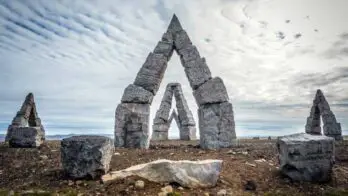Nestled in the dry plains of Peru, between the Andes and the Pacific, flanked by two rivers, Nazca and Grande, lies one of the world’s most remarkable and mysterious ancient wonders – the Nazca Lines.
These enormous geoglyphs, etched into the desert floor, have been a subject of fascination and speculation for centuries, captivating the imaginations of scholars, explorers, and enthusiasts alike.
An Introduction to One of the World's Greatest Mysteries
The Nazca Lines consist of hundreds of massive figures, ranging from simple lines and shapes to complex geometric forms, animals, and humanoids.
The geoglyphs are located in the Nazca Desert, roughly 400 kilometers south of Lima, covering an area of about 450 square kilometers.
The lines were first brought to the attention of the Western world in the 1920s by Peruvian archaeologist Toribio Mejia Xesspe, who was conducting a survey of the region.
However, the true scale and complexity of the lines were not fully appreciated until the 1940s, when American explorer Paul Kosok conducted a series of extensive surveys and studies.
Since then, numerous expeditions and research projects have been carried out to unravel the mystery of the Nazca Lines.
Despite decades of investigation, however, the purpose and meaning of the geoglyphs remain elusive, shrouded in a veil of speculation and intrigue.
Who Built the Nazca Lines and Why?
The Nazca Lines are believed to have been created between 500 BCE and 500 CE, during the Paracas phase of South American history.
The lines were etched into the desert floor by removing the reddish-brown iron oxide-coated pebbles that cover the surface, revealing the light-colored earth underneath.
Despite the harsh desert climate, this process has preserved the lines for over a thousand years.
There are over 800 known figures, including more than 70 animal, plant designs, geometric shapes, and lines spanning over 30 kilometers.
The largest figure, known as the Hummingbird, is around 97 meters long. The designs can only be fully appreciated from the air, which has led to many theories about their intended purpose.
The Nazca Lines were first mapped and studied extensively by Maria Reiche, a German mathematician, and archaeologist who dedicated over 50 years of her life to studying the geoglyphs.
Reiche’s work helped to shed light on the astronomical alignments of the figures, leading to speculation about their possible connection to ancient rituals and ceremonies.
Cahuachi and the Clay Pyramids
Cahuachi is an ancient ceremonial center in the Nazca desert, approximately 28 km from the Nazca Lines.
It was discovered in the 1920s and was one of the largest urban centers in the region. Excavations at Cahuachi have revealed the presence of pyramids made of adobe bricks, similar to those found at other sites in the area.
One theory suggests that the Nazca Lines were created as part of the rituals performed at Cahuachi.
According to this theory, the Nazca people used the lines to mark sacred areas’ boundaries and create paths for processions during religious ceremonies.
This idea is supported by the many lines converging at Cahuachi and other nearby ceremonial centers.
Additionally, the discovery of pottery and other artifacts at Cahuachi has led researchers to believe that the Nazca people had a highly developed society with a complex religious and social hierarchy.
The presence of the pyramids also suggests that they had advanced engineering skills and may have used the same techniques to create the Nazca Lines.
The Astronaut Figure: A Clue to the Mystery of Nazca Lines?
One of the most intriguing figures among the Nazca Lines is the so-called “Astronaut,” which depicts a human figure wearing what appear to be space suits, complete with helmet, gloves, and boots.
This figure has fueled much speculation and debate about the origins and purpose of the Nazca Lines.
The Astronaut figure is one of the largest and most complex among the Nazca Lines, measuring around 32 meters (105 feet) in length. The astronaut figure is depicted in a slightly reclined position, with its arms and legs spread apart as if in a crucifixion pose.
Many theories have been put forth to explain the astronaut figure, with some suggesting that it represents an extraterrestrial being or an ancient astronaut visiting Earth.
Others argue that it is a representation of an Inca or pre-Inca deity, possibly connected to the worship of the sun or other celestial bodies.
Astronomical alignments have also been noted in connection with the astronaut figure, leading some to speculate that it was used as part of an astronomical calendar or observatory.
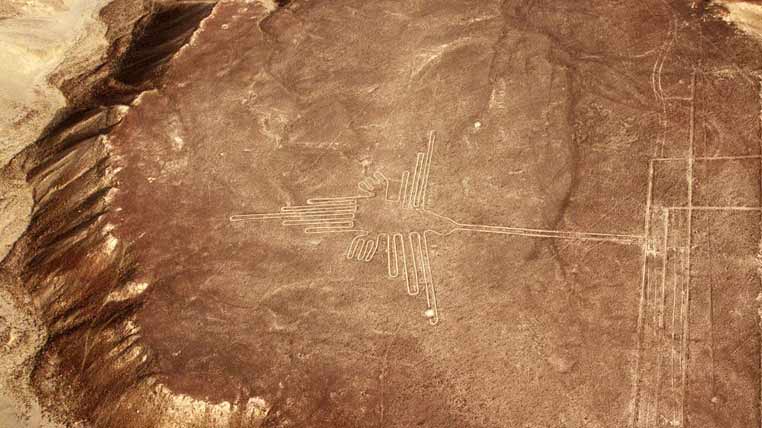
Underground Water Circuits and Other Theories
The ancient Nazca people ingeniously tapped into the groundwater springs that emerged to the surface, forming puquios, a complex system of underground aqueducts that provided water for agriculture and possibly for creating geoglyphs.
Initially, it was believed that the geoglyphs served as water channels.
Still, the first pilots who flew over the region in the 1930s reported the existence of a much more extensive and varied collection of geoglyphs than previously thought, leading to further speculation about their function.
The first modern scientific examination of the region was conducted by Toribio Mejía, a Peruvian archaeologist, who presented his findings at an international archaeology conference in Lima in 1939.
Mejía discovered that the models indicate a great complexity of trapezoid-type geometric figures, including rectangles with one side longer than the one it is parallel to, triangles, and rectangles.
In addition, more than 40 animal shapes (including a monkey, a spider, a dog, a llama, and a bird with a tail over 50 meters long) and some spiral forms have been discovered.
Ancient Underground Water Systems
The idea that the Nazca Lines are, in fact, an ancient underground irrigation system dates back to their rediscovery in the 1920s when scientists analyzed irrigation techniques in the region.
A local myth speaks of a huge sand dune called Cerro Blanco, which was believed to hide a big lake that fed underground water canals or once erupted to the surface, irrigating the region.
“Radiant centers,” in which several lines intersect, are located at the base of hills and at the edge of the raised lip of a valley, where seasonal rivers flow.
Many lines follow the direction of watercourses and often end abruptly near a river.
This connection between the lines and water sources has been interpreted in relation to faith.
Ancient ritual processions probably took place in areas where people expected the water to collect.
According to this theory, the population traveled along the Nazca lines to areas where the water came from and brought offerings to the gods or uttered prayers, imploring the abundance of the vital liquid.
The most significant number of lines appears around Valle Ingenio, where seasonal rivers are formed from the moisture accumulated on the slopes of the Anzil Hills.
The site has become the primary study site for archaeologists, particularly helping them to detect irrigation routes to the seasonal rivers.
Two ancient settlements, Cahuachi and La Estaqueria, have also been found in the area.
Cahuachi shelters buildings nearly 3 km long and 1 km wide, including 20-meter-high pyramids, village squares, and cemeteries.
Based on the radiocarbon dating of the ceramics found here, it has been established that the modest community developed between 100-600 AD.
Similar ceramics found along the lines leading to Cahuachi date back to 800 AD, suggesting that this center might have been abandoned around 600 AD but remained an important ceremonial site for another two centuries.

Constellations and Nazca Lines: An Ancient Map of the Universe?
One of the most popular theories is that the enormous shapes were created for astronomical purposes.
In 1941, historian Paul Kosok from Long Island University, New York, visited Nazca to investigate the irrigation networks of modern civilizations.
While resting on top of a hill, he noticed a line that went directly to the sunset point of the Sun on June 21, the winter solstice day in the southern hemisphere.
This discovery would lead to the study of the astronomical significance of the Nazca Lines. The theory was supported by the fact that many lines and shapes align with the positions of celestial bodies, including the sun, moon, and stars.
Later, archaeologists began to link the geoglyphs to constellations.
The image of the colossal monkey was attributed to the Great Bear (or Ursa Major in the northern hemisphere), and it was considered that other figures corresponded to the Pleiades and Orion.
During his visit, Kosok was accompanied by Maria Reiche, a translator and mathematician from Lima.
Reiche’s fascination with the lines led her to stay in Nazca for the next 50 years, making the study of pictograms her fundamental activity.
She published her findings in the book Contributions of Ancient Peru to the History of Geometry and Astronomy in 1993.
Despite many theories proposed to explain the purpose of the Nazca Lines, the idea that they were used for astronomical observations was challenged with convincing evidence.
In 1967, astronomer Gerald Hawkins from Boston University used a computer to create a sky map covering a period of 7,000 years above the Nazca region.
His study found that the alignments should regularly correspond to important astronomical events, such as the rising or setting of stars, the sun, and the moon.
However, out of the 136 lines he examined, only 39 were aligned with the extreme positions of the sun or moon, and just a few of these had a connection with important celestial bodies.
When Hawkins tried a similar experiment with stars, using a catalog of their positions from 10,000 BC to the present day, he found that the number of alignments was statistically insignificant.
An Ancient Calendar?
Another proposed theory suggests that the Nazca Lines served as some sort of calendar.
While only 20% of the lines align with the rising and setting of the Sun and Moon, the ones corresponding to the solar movements indicate that the geoglyphs may have served as a way to mark the passage of time.
This would have allowed the locals to prepare for seasonal changes, such as floods and droughts, and organize their agricultural practices accordingly.
Another theory comes from archaeologist Helaine Silverman from the University of Texas, who proposed that the lines were created during a drought when the people of Cahuachi, the ceremonial center of the region, lost faith in their priests.
Given the water scarcity in the region, water rituals likely held great importance for the Nazca population.
Indeed, some shapes appear to correspond to constellations, while others resemble aquatic animals such as frogs, ducks, and whales, which are also depicted on Nazca pottery.
These images could have been used in rituals to communicate with animal spirits.
Research conducted by professor Anthony Aveni of Colgate University suggests that the Nazca civilization practiced the magic of water.
Aveni’s study of over 800 Nazca Lines revealed that approximately 62 points where the lines converge overlap with corners, loops of rivers, and high lakes in the Andes, from which water flowed.
Aveni believes that the Nazca lines were traversed by locals as part of water rituals, during which they prayed for the fertility of their lands.
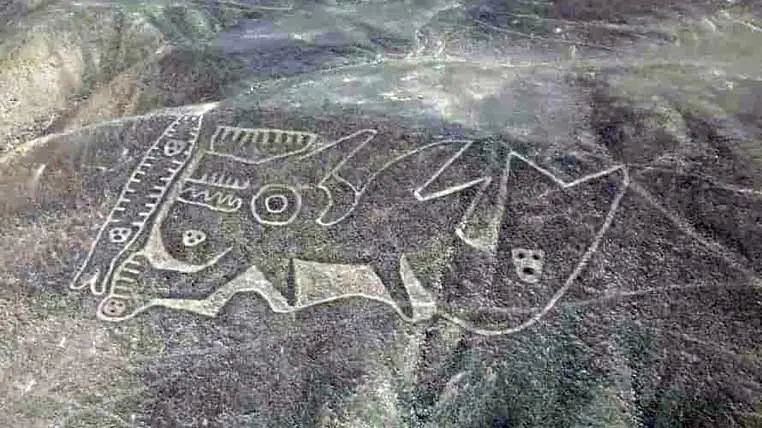
Erich von Däniken's Theories
As archaeologists and scientists continue to try to come up with a universally accepted explanation for the purpose of the Nazca geoglyphs and how they were traced with such precision by an almost unknown civilization, Erich von Däniken’s idea that extraterrestrial beings created these extraordinary shapes is gaining ground.
Daniken was one of the first to conduct complete flights over the Nazca region, analyzing both the geoglyphs in the low areas of the plateau and those on the hills of Nazca.
He found intricate mathematical diagrams that had never been studied before and based his research on several simple concepts and facts.
Nazca geoglyphs are intricate lines scattered throughout the desert, forming remarkable pathways. The largest figure measures almost 305 meters, or the size of three soccer fields, while the longest line stretches over 14 km.
Von Däniken raised some of these questions, including why the Nazca people needed to create these elaborate designs and what is their intended purpose.
Furthermore, the Nazca Lines can only be seen and appreciated from the sky, which raises the question of why they were drawn in such a way, especially during a time when airplanes did not exist.
The figures’ magnitude makes them such a complex undertaking, even though they are relatively easy to create by removing the surface layer of the desert.
Among the geoglyphs on the Nazca plateau is a huge triangle that stretches across no less than 15 square kilometers.
Modern measurements have shown that the geometric figure is of extraordinary precision.
From an airplane or a helicopter, it appears that the triangle was made by pressing the ground to a depth of at least 60 cm.
This raises questions about what kind of technology the Nazca people had at their disposal to create such a precise and massive design.
Today, many historians and anthropologists believe that the people of Nazca were one of the predecessors of the Inca civilization, the largest pre-Columbian empire in South America that flourished in the Andes Mountains region of South America in the 13th century.
But here, von Däniken’s theories become even more fascinating and intriguing.
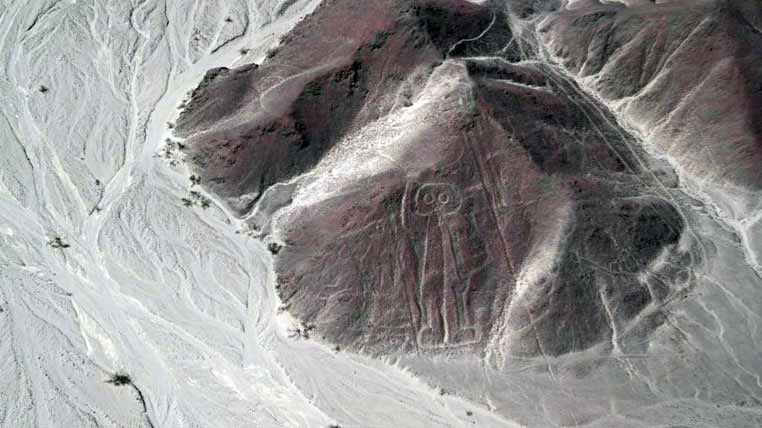
Who Was Viracocha, the Mysterious Inca Creator God Behind the Nazca Lines?
Erich von Däniken has written extensively about ancient civilizations and their possible contact with extraterrestrial beings. In his book “Chariots of the Gods?” published in 1968, he suggested that the Nazca Lines were created by ancient astronauts who visited the Earth thousands of years ago.
Von Däniken believed that the Nazca Lines were landing strips or runways for alien spacecraft and that the ancient Nazca people created them under the guidance of extraterrestrial beings.
He argued that the lines could only be fully appreciated from the air and that this was evidence that the Nazca people had access to advanced technologies and knowledge beyond their time.
According to von Däniken’s theory, the Nazca Lines were part of a more extensive network of ancient sites that served as communication centers for the aliens.
He also believed that many other ancient structures worldwide, such as the pyramids of Egypt and the stone heads on Easter Island, were created with the help of extraterrestrial technology.
According to von Däniken, one such extraterrestrial being is Viracocha, one of the most important gods of Inca mythology, who created the world and all life on it, including humans. Viracocha was known for his miracles, such as turning stone into gold and raising the dead.
He was considered the most powerful of all the gods worshipped by the Incas, and his influence extended throughout the Andes region of South America.
The influence of Viracocha can also be seen in the design and construction of other Inca structures. The famous Machu Picchu, for example, is believed to have been built as a sanctuary to honor Viracocha.
However, the origins of Viracocha remain a mystery, and it is unclear if he has any connection to Sumer or the Anunnaki. Nevertheless, similar legends and stories of great gods appear throughout the Americas and the rest of the world.
Beyond the Mystery: What We Can Learn from the Nazca Lines Today
Firstly, there are certain aspects on which experts agree.
First, the Nazca lines were created by removing the top layer of stones, revealing the lighter soil underneath.
Secondly, it is widely accepted that creating these designs requires tremendous effort and hundreds of years of work.
Due to their size, the creators would have never seen the finished product on the ground. In fact, the Nazca lines are so subtle that the Panamericana was built straight through them without any workers noticing anything unusual.
Most silhouettes are stylistically similar to the drawings and paintings found in local ceramics. However, scaling these images up was more straightforward than it might seem.
Only basic trigonometry knowledge was needed, and tools such as strings, wooden pegs, and drawing boards were likely used.
The mystery surrounding the Nazca lines lies not in how these enormous images were created but rather in why someone would expend so much effort to make them.
So could Erich von Däniken be correct?
While the scientific community has widely criticized von Däniken’s theories, his work has inspired numerous books, documentaries, and even a TV series exploring the possibility of ancient aliens visiting Earth.
At Ancient Theory we only use trusted sources to document our articles. Such relevant sources include authentic documents, newspaper and magazine articles, established authors, or reputable websites.
- Leo Deuel - Conquistadors without Swords: Archeologists în the Americas. St. Martin’s Press, New York, 1967.
- Nazca Lines. wikipedia.org. [Source]
- Lindsay Faber - The Nazca Lines - Professor Offers Theory on the Origins of Mysterious Mosaic. Greenwich Time, 2001.
- Jason Golomb - Why the Nasca lines are among Peru's greatest mysteries. nationalgeographic.com.
- Daniel Rennie - Unlocking The Mystery Of Peru’s Massive Nazca Lines.
- Nancy Bilyeau - The Mystery of Peru’s Nazca Lines Just got Weirder with New Revelations.
- Dan Collyns - Scratching the surface: drones cast new light on the mystery of Nazca Lines.
- The Nazca Lines are a mystery in the Peruvian desert. Oxford Business Group Publication.
- Joe Nickell - Unsolved History: Investigating Mysteries of the Past. The University Press of Kentucky.
- Meilan Solly - Scientists Identify Exotic Birds Depicted in Peru’s Mysterious Nazca Lines. Smithsonian Magazine.
